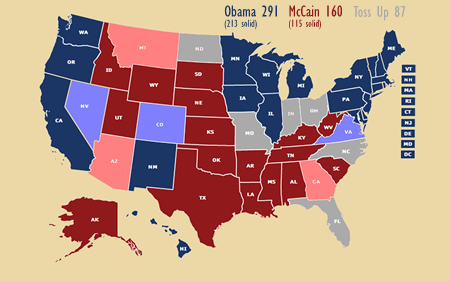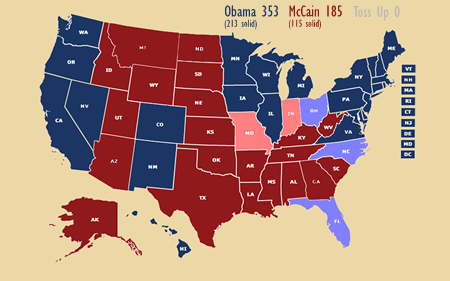Tue 4 Nov, 2008
Final analysis before the presidential election
Comments (1) Filed under: PoliticsTags: Barack Obama, John McCain, Presidential election
This is my final analysis of the state of the presidential election before we begin seeing returns this evening.

As virtually everyone in the nation is now aware, Barack Obama has a significant lead in the national polls, and corresponding leads in enough states to give him a decisive edge going into this election. At the national level, he leads by roughly 7 percentage points in the polls; four years ago, George W. Bush lead by about 1.5 percentage points. In the electoral college, Obama currently leads among states with 291 votes to McCain’s 160, with 87 votes in toss-up states.
Why is Obama’s lead so strong? On one level, political scientists have been predicting a Democratic victory all along, based on a handful of factors—the state of the economy, which is the incumbent party, the incumbent’s popularity (or lack thereof)—which have nothing to do with either candidate or how the campaign season unfolds.
On another level, perhaps merely because of the factors I’ve just mentioned, polling indicates that Obama has take a strong lead because voters have come to form positive opinions about him. For instance, the Wall Street Journal points out that voters are now just as likely to identify with Obama’s background and values as they are with McCain’s. This is a significant accomplishment for a candidate like Barack Obama, and illustrates just how much his perceived weaknesses with the voters have evaporated. USA Today, meanwhile, has poll results which suggest that McCain no longer has a lead with voters even on national security issues, and despite his relentless focus on taxes, voters are evenly split on the question of whether their taxes would be higher under Obama or McCain.
The electoral college battle
This election night will be about more than merely learning the margin of victory, however. John McCain certainly has a chance, albeit a slim one, to pull off an upset win.
Because of the magnitude of the challenge facing McCain, only a handful of states truly matter in determining the outcome of this election. These states are Virginia, Pennsylvania, Colorado, Ohio, and Nevada.
Note that these critical states are not the same as the battleground states, that is, the states which are, or have recently been, toss-ups. States such as Florida, Indiana, Missouri, North Carolina, and even North Dakota are too close to call, but are unlikely to be the deciding states in this election. To win, McCain will have to “run the table” by winning most or all of the toss-up states, but because he must also take states in which Obama has a sizable lead, if he can win those critical states, the remaining toss-up states should fall into place.
As the map above indicates, Obama currently leads in states with 291 electoral votes, 21 more than are needed to win, before even considering those toss-up states in which he has a slim lead. As a result, McCain must win all of the toss-up states, or their equivalent, and still find 22 electoral votes among states with clear Obama leads.
This is why the McCain campaign strategy in recent weeks has focused on Pennsylvania. This would not otherwise be considered a battleground state, as Obama has maintained a solid lead in the state for many weeks. However, Pennsylvania’s 21 electoral votes would essentially give McCain what he needs from the Obama column in order to have a shot at winning the election, and it is easily the most likely such state, or combination of states, in which McCain could score an upset victory. After intense attention in the last couple of weeks, McCain has narrowed Obama’s lead in Pennsylvania somewhat, but Obama still leads by roughly 7 or 8 percentage points.
If McCain wins Pennsylvania, he could win an upset victory by winning all of the toss-up states (shown above) and taking any other state from among those now leaning to Obama. Nevada would be the most likely such state, followed by Virginia, Colorado, New Mexico, and New Hampshire, in that order. If he loses any of the toss-up states, he must make them up from among this short list of states, or an even bigger upset. Thus he could lose North Dakota without winning anything more; if he loses Indiana or Missouri, he must win Virginia or a combination of states; and if he loses North Carolina, Ohio, or Florida, or more than one toss-up state, he must win an increasing decisive combination of states now leaning towards Obama.
If McCain fails to win Pennsylvania, which seems probable, his chances to win the presidency dim considerably. To make up for Pennsylvania, he would have to score upsets in both Colorado and Virginia, or in a larger combination of states. Without Pennsylvania or Virginia, it would take upsets in Nevada, New Hampshire, and New Mexico, with little or no margin for error among the toss-up states.
What are the most likely victory scenarios for McCain, assuming that he’s most likely to win in the states where he’s been polling best? Statistically, the most likely scenario is that he loses in Pennsylvania but wins upsets in Virginia, Colorado, and Nevada, as well as taking the toss-up states. Another likely scenario results in involves winning Pennsylvania and Nevada. Using this method of analysis, McCain cannot win the election without enough support to win Florida, Missouri, and Indiana, and in winning the election would almost certainly take North Carolina and Ohio.
Finally, how would we know if Obama has won the election? If he can hold onto Pennsylvania, he has almost certainly won. At that point, securing a victory in Virginia would guarantee a victory, as would a win in Florida or Ohio. As the latter two states are likely to be close elections, it is perhaps more likely that a win in Colorado would put Obama over the top.
In terms of a landslide victory, there could be other surprises tonight, particularly ones which would favor Obama. In the latest poll in Alaska, for instance, where McCain is heavily favored to win, the two candidates were separated by only three percentage points.
Interpreting the polls
How likely is it that McCain could win enough of the undecided vote to significantly increase his chances in multiple states? The undecided vote is perhaps not as helpful to his chances as the odds that the polls have been estimating likely voters incorrectly or otherwise failing to capture who will vote on election day. Historically, undecided voters do not break overwhelmingly for one candidate or the other; instead, they usually split between 60-40 and 50-50, with an edge to party out of power and with no more than a 2-1 split in the last sixty years.
What, then, might the polls be getting wrong that could be masking enough McCain support to win the election?
The most significant factor is that every polling organization adjusts their results based on estimates of who is likely to vote. The likely voter models in use this year range from traditional ones (heavily biased towards who voted in past elections) to ones which assume newly registered or newly enthusiastic voters will turn out in large numbers. However, Obama has strong leads even in polls using the more traditional likely-voter models.
The Bradley effect has been widely discussed among polling professionals and political scientists for a generation, and has received a great deal of public attention in an election cycle with a prominent black candidate. The Bradley effect is often misunderstood, even among experts, but it refers to the possibility that voters could tell pollsters that they will vote for the black candidate, and yet end up voting for the white candidate. Explanations for this phenomenon include voters being uncomfortable admitting to pollsters that they will not vote for a black candidate, to unconscious racism on election day. In any event, there has been excellent work done this year which suggests that any Bradley effect in past years is no longer an appreciable factor. Whether this is true in the first presidential election to feature a leading black candidate cannot be known for certain until after Election Day.
Traditional polling does not reach voters who only use cell phones. However, there is good reason (including common sense and analysis of poll results with cell phone users included) to believe that properly including cell phone users who only increase Obama’s lead in the polls.
There are other reasons why polls may be systematically biased, including voter non-response. Polling organizations are notoriously reluctant to reveal how many of those contacted respond to their inquiries, but the percentage of respondents is believed to be quite low. If those who respond are systematically different in their political views than those who do not, this could easily introduce a significant bias in the poll results. For instance, if a demographic that often refuses to respond to surveys (the example often used is older, white, less-educated voters) tends to be politically conservative or, in this case, racially intolerant, the polling models must properly weight the results to account for this group, or the poll results will be systematically wrong.
Prediction
Finally, here is my projection of tonight’s election results. Please note that a variety of scenarios are possible, ranging from Obama only holding onto his current lead of 291 electoral votes, to Obama results of 311, 338, or even 364 electoral votes. While I’ve made a prediction for every state, I’ve also indicated which states I think will be especially close.

2012 election day prediction | The Living Consequences says:
[…] year, for reference, I correctly predicted 49 of 50 states. The state I missed was Indiana, which I saw narrowly going to […]